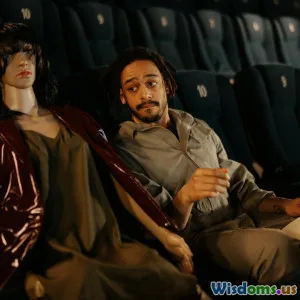
From Script to Screen: Secrets Behind Successful Film Adaptations
7 min read Explore the art and strategy behind turning scripts into acclaimed film adaptations with real examples and insider insights. (0 Reviews)
From Script to Screen: Secrets Behind Successful Film Adaptations
Film adaptations hold a magnetic allure—they promise fans a visual journey into beloved stories while challenging filmmakers to honor the source material's essence. Yet, not all adaptations resonate equally. What differentiates a successful film adaptation from a forgettable one? How do adaptations navigate the intricate balance between loyalty to the original work and crafting a compelling cinematic narrative?
In this article, we delve into the nuanced process of transforming scripts into screen masterpieces. By examining critical factors such as source material selection, screenplay adaptation techniques, directorial vision, casting, and audience expectations, we uncover the secrets behind some of the most successful film adaptations in cinema history.
Understanding the Foundation: Choosing the Right Source Material
The journey begins with choosing a source worth adapting. Not every book, play, or comic has natural potential for the big screen. A successful adaptation requires material with rich narrative texture, cinematic appeal, and adaptable themes.
Case Study: The Lord of the Rings Trilogy
Peter Jackson’s selection of J.R.R. Tolkien’s epic fantasy novels was ambitious. Tolkien’s work, dense and sprawling, posed challenges with intricate world-building and complex themes. Jackson’s team invested years in understanding the novels’ mythology, emphasizing fidelity to the spirit rather than literal scene-by-scene reproduction.
Jackson later stated, “You can’t just make the movie a direct copy; you have to bring your own interpretation to give it life.” The selected source’s depth and iconic status created a foundation that, paired with thoughtful adaptation, helped ensure massive success.
Script Adaptation: Striking the Balance Between Faithfulness and Innovation
Adapting a script involves more than transcription—it requires reimagining stories for a different medium. A screenplay adapts push and pull moments: staying faithful to beloved story arcs while making narrative decisions that suit pacing, visual storytelling, and character development.
Fidelity Versus Filmic Needs
As George Lucas famously acknowledged with Star Wars adaptations of words and themes from older mythology, "Belief in the made-up story becomes the key." Balanced adaptations retain core themes but may condense plots or reshape characters to serve cinematic flow.
Example: The Shawshank Redemption
Stephen King's novella, "Rita Hayworth and Shawshank Redemption," was relatively short with a sparse plot. The film’s screenplay, crafted by Frank Darabont, expanded minor characters and enhanced emotional stakes. By doing so, the adaptation elevated a concise story into an emotionally immersive narrative acclaimed worldwide.
The Director’s Vision: Crafting a Unique Cinematic Experience
Directors serve as storytellers translating scripts into unfolding motion pictures. Their vision determines tone, visual style, pacing, and thematic emphasis.
Guillermo del Toro and Pan’s Labyrinth
Though originally an original screenplay, del Toro’s film is a study in blending fantasy with grim realities, much like adaptations that reinterpret source material. His directorial choices in lighting, symbolism, and color underscore how a director’s vision amplifies narrative impact.
Collaboration Is Crucial
Directors closely collaborate with writers, producers, and actors. For adaptations, honoring the author’s intent while injecting artistic flair often requires delicate balancing for audience satisfaction.
Casting: Breathing Life Into Beloved Characters
Choosing actors is more than securing star power; it’s about authentic embodiment of characters, sometimes serving as a repre-sentation for fans’ imaginations.
Example: Daniel Radcliffe as Harry Potter
Radcliffe grew with the film series, providing continuity and deepening character believability. His portrayal played a pivotal role in the franchise’s global appeal and acceptance by its enormous fanbase.
Miscasting can alienate audiences or hamper an adaptation’s reception, as seen in the less successful Eragon film, widely criticized for mismatched casting choices.
Navigating Audience Expectations and Marketing
Adaptations come with fanbase expectations. Disappointment can lead to backlash, while praise amplifies success.
Strategic Marketing and Managing Expectations
Marketing campaigns that highlight both commitment to source material and the distinct cinematic flair help set appropriate audience expectations. The Game of Thrones TV series (an adaptation of George R.R. Martin’s novels) exemplified this by carefully cultivating fan excitement through detailed teasers and interactive content.
Evaluating Success: Critical Acclaim and Box Office Performance
Successful adaptations often marry critical acclaim with commercial success.
- Forrest Gump (1994) adapted from Winston Groom’s novel, grossed over $677 million worldwide and won six Academy Awards.
- To Kill a Mockingbird’s (1962) film adaptation is lauded for respecting Harper Lee’s themes while creating powerful cinematic moments.
Yet, some cult classic adaptations underperform at the box office but sustain long-term cultural impact, proving that success metrics can be multidimensional.
Closing Thoughts: The Eternal Dance Between Page and Screen
Transitioning a story from script to screen calls for craftsmanship, respect for the source, creative innovation, and awareness of audience sentiment. When these elements harmonize—as in The Godfather or The Hunger Games series—an adaptation captures hearts and minds, sometimes eclipsing the original medium’s reach.
Aspiring filmmakers and enthusiasts alike can glean lessons from studying this journey: success in adaptations demands not just "following the script," but breathing fresh life into storied words, inviting viewers on visual, emotional journeys that lasting cinema is built on.
References:
- Peter Jackson interviews on The Lord of the Rings adaptation process
- Interviews with Frank Darabont on The Shawshank Redemption
- Box Office Mojo for performance data
- Historical audience reception studies and critical reviews
Rate the Post
User Reviews
Popular Posts















